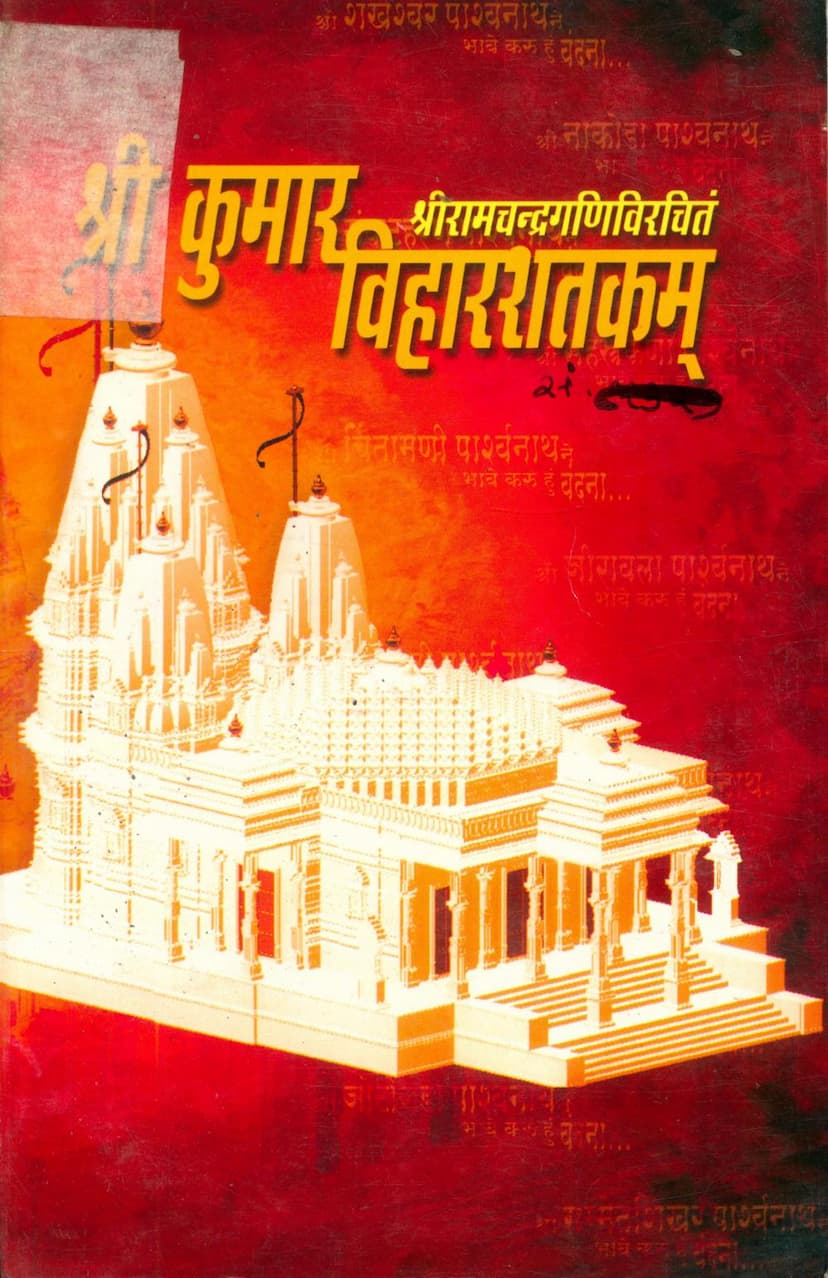Kumar Viharshatakam
Added to library: September 2, 2025

Summary
Here's a comprehensive summary of the Jain text "Kumar Viharshatakam," based on the provided pages:
Book Title: Kumar Viharshatakam (कुमार विहारशतकम्) Author: Ratnabodhivijay (as editor), Ramachandra Gani (original author) Publisher: Shri Jinshasan Aradhana Trust Catalog Link: https://jainqq.org/explore/005880/1
This book, "Kumar Viharshatakam," is a significant Jain text that describes the magnificent Kumarvihara temple, built by the renowned Jain King Kumarpal. The text is presented with the original verses (Mul), commentary (Avachurni), explanation of meaning (Bhavarth), and detailed exposition (Vishesharth).
Historical Context and Significance:
- The text focuses on the Kumarvihara, a temple constructed in Patan by King Kumarpal in memory of his father, Tribhuvanpal.
- King Kumarpal, a devout follower of Jainism, was influenced by the teachings of the esteemed Jain monk Acharya Hemchandrasuri. He embraced Jainism later in life and lived a life of piety and adherence to Jain principles.
- Kumarpal was known for his patronage of Jainism, including the construction and renovation of numerous temples, establishing libraries, and promoting non-violence throughout his kingdom. He even instituted a decree of non-violence across 18 countries.
- The temple, Kumarvihara, was a grand structure described in detail by Ramachandra Gani, a prominent disciple of Acharya Hemchandrasuri. This work, "Kumar Viharshatakam," is essentially Ramachandra Gani's poetic description of this temple.
- The text mentions that the original composition consists of over a hundred verses (shatak), detailing the temple's architecture, the idol of Lord Parshvanath, and the general grandeur of the complex.
- The current publication is a re-edited version, made possible through the inspiration and efforts of various Jain scholars and trusts, acknowledging the contributions of individuals and organizations dedicated to preserving and propagating Jain literature.
Content and Structure:
The "Kumar Viharshatakam" is a devotional and descriptive work, primarily focusing on:
-
Devotional Obeisance (Mangalacharan): The initial verses offer prayers and invocations to Lord Parshvanath. These verses highlight his divine attributes, such as his power to overcome sins, his role as the source of eternal bliss, his manifestation with seven jewels on his hoods, and his ability to destroy the eight karmas. The verses use rich metaphors and elaborate descriptions to glorify the Lord.
-
Temple Description (Kumarvihara): The bulk of the text is dedicated to vividly describing the Kumarvihara temple. This includes:
- The Central Idol: The idol of Lord Parshvanath, crafted from precious gems and materials, is a central focus.
- Architectural Grandeur: The verses detail the temple's magnificent architecture, including its height, the use of precious stones like moonstone (Chandrakantmani), sapphire (Neelmani), ruby (Padmarag), and gold. The descriptions paint a picture of opulent pillars, intricate carvings, shining walls, and jeweled decorations.
- Artistic Embellishments: The text describes the artistic aspects, such as murals and paintings on the walls, which are so lifelike that they appear to have their own reflections and are described with various allegorical comparisons (e.g., to the celestial river Ganga, the moon, etc.). The text even notes how the artistic representations were so captivating that they sometimes confused or affected the viewers, including celestial beings and animals.
- Sensory Experiences: The verses appeal to multiple senses, describing the beauty of the idols, the fragrances used in rituals (like camphor and aguru), the sounds of music and bells, and the overall devotional atmosphere.
- Miraculous Elements: The text suggests miraculous occurrences related to the temple, such as the possibility of obtaining divine boons, the healing of diseases, and the manifestation of divine presence, all attributed to the sanctity and glory of Lord Parshvanath and the temple itself.
- Devotional Activities: It mentions the rituals performed, such as the Snatra (ritual bathing of the idol), the use of various materials for worship, and the presence of devotees from all walks of life, including kings, merchants, and common people.
- Metaphorical Comparisons: The author frequently uses metaphors to convey the temple's magnificence, comparing it to celestial palaces, divine beings, and even the heavens themselves, suggesting that earthly beauty pales in comparison to the Kumarvihara.
-
The Role of King Kumarpal: The text emphasizes King Kumarpal's devotion and his role in the temple's creation, highlighting his commitment to Jain principles and his role as a righteous ruler. His pious deeds and adherence to the 12 vows of a Jain layman are alluded to.
-
Commentary and Interpretation: The "Avachurni" provides detailed explanations of the verses, clarifying the meaning of words, grammatical structures, and the underlying symbolism. It helps the reader understand the intricacies of the poetic language and the devotional intent.
Key Themes:
- Devotion to Lord Parshvanath: The paramount theme is the intense devotion and reverence for Lord Parshvanath.
- Magnificence of Jain Temples: The text serves as a testament to the architectural and artistic splendor of Jain temples during that era.
- The Power of Jain Faith: It underscores the spiritual benefits and auspiciousness derived from worshipping Lord Parshvanath and visiting holy sites.
- The Legacy of King Kumarpal: The work celebrates the righteous reign and devotional life of King Kumarpal.
- The Skill of Jain Poets and Scholars: The sophisticated language, elaborate metaphors, and detailed commentaries highlight the rich literary tradition within Jainism.
In essence, the "Kumar Viharshatakam" is a devotional poem that not only praises Lord Parshvanath but also offers a detailed and awe-inspiring architectural and artistic description of the Kumarvihara temple, painting a vivid picture of Jain devotion and royal patronage in ancient India.